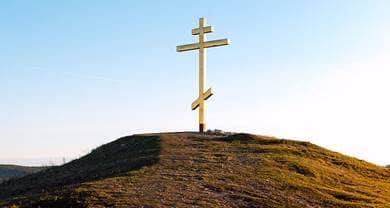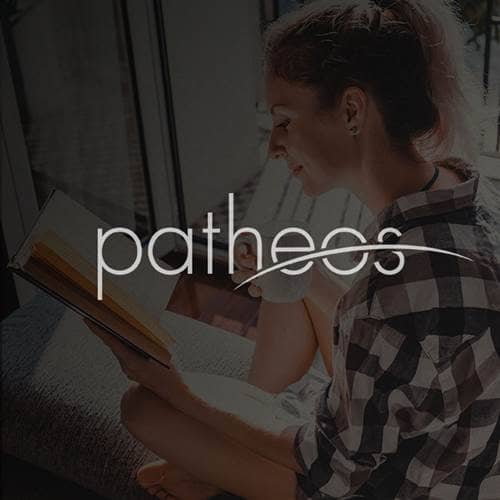- Trending:
- Easter
- |
- Lent
- |
- Forgiveness
- |
- Resurrection
- |
- Joy
- |
- Feminism

RELIGION LIBRARY
Eastern Orthodoxy
Sacred Space
A typical Eastern Orthodox church building is square in shape, covered by a dome, with a wide central space called the nave, which is devoid of pews or other furniture. Benches or chairs can often be found along the outer walls. The building is divided into three sections, in memory of the three sections of the Temple in Jerusalem. Congregants enter at the western end of the church into the vestibule, called the narthex. In earlier times, visitors who were not yet baptized and confirmed in the church were not allowed to proceed beyond the narthex. Some congregations still adhere to this rule.
The main section of the church, the nave, is where the congregants gather for the service, or Divine Liturgy. Although Eastern Orthodox Christians traditionally stand and move about for the duration of the service, in some churches, especially in the U.S., pews and kneelers have been installed. The section at the eastern end of the church is called the sanctuary. The sanctuary is always placed at the eastern end of the church, so that the congregation faces the sunrise, symbolically the source of the divine light. The altar, also called the Holy Table or Throne, is in the center of the sanctuary. The bishop's throne is behind the altar and against the east wall.
The sanctuary is divided from the rest of the church by a screen called an iconostasis. This is a solid screen, typically made of wood and covered in icons. The iconostasis has three doors. The largest, in the center, is called the Royal Door and is only used by ordained clergy. Traditionally this door is left open in order to give the congregants a view of the altar, while at times during the service the door is closed and a curtain is drawn. This is also changing in some locations. In some Greek parishes, the door remains open throughout the service, or has been removed altogether.
From the perspective of the nave, the doors to the left and right of the Royal Door are called the Angel Doors and have paintings of the Archangels Michael and Gabriel. The door to the left leads into a small chapel called the Prothesis in which the priest prepares the bread and wine at the start of the Divine Liturgy. The door on the right leads to a small chapel called the Diakonikon, which once held the scripture and the relics, and is today used as a vestry. The laity is not permitted beyond the iconostasis unless they are serving at the Mass.
The church is filled with icons. Icons are on the walls, in special shrines, on a special stand called an analogion, and on the iconostasis. The iconostasis might have multiple rows of icons, with rows dedicated to specific subjects. One row will hold icons of the Twelve Great Feasts, one will hold icons of the apostles, one will hold icons of the prophets, and so forth. A cross with an icon of the crucified Christ is placed at the highest point above the iconostasis.
The square shape of the building symbolizes the cross. There are also rectangular church buildings, which symbolize the Ark of Noah carrying the faithful to salvation. Octagonal church buildings symbolize the star that guides the faithful as the star guided the magi. Circular buildings remind the believer that the church is eternal, without beginning or end. Eastern Orthodox church buildings are recognizable by the large dome placed over the nave. The dome symbolizes heaven. It is typically painted with a large icon of Christ called the Pantocrator, or "Ruler of All." The domes of Russian churches have a distinctive onion shape, perhaps so that snow cannot accumulate. As side chapels were added to the main church building, more domes were added, leading to some spectacular examples of Christian architecture.
The church building as a whole and each of its parts, including the decorations and the careful arrangement of the icons, has its place in a system of symbols that informs the architecture and arrangement of the church. The icons, points of meeting between heaven and earth, are the visible evidence of heaven on earth. The icons of Christ Pantocrator, the Theotokos or Mother of God, and all the angels and saints assure congregants that the whole company of heaven is present during the Divine Liturgy. The icon-covered walls are believed to be open doorways between heaven and earth, so that the walls of the church open out into eternity. The church and all its parts comprise one great icon of the Kingdom of God, so Orthodox Christians are part of the great liturgy of heaven when they are in church. The building is a part of the world to come.
Every Orthodox church is consecrated to God, a saint, or one of the feasts, so that churches will have names like Church of Christ the Savior, Church of Saint Andrew, Cathedral of Saint Basil, or Church of the Annunciation. The most famous church building in all of Eastern Orthodoxy is the Hagia Sophia in modern-day Istanbul, or the Church of the Divine Wisdom. Hagia Sophia was used as a mosque after the Ottoman conquest of Constantinople in the 15th century, and is now a museum.
Study Questions:
1. Describe the architecture of Eastern Orthodoxy’s churches.
2. How do Eastern Orthodoxy’s followers move through sacred space?
3. What is the iconostasis? What purpose does it serve?
4. Should icons be viewed similarly to idols? Why or why not?










